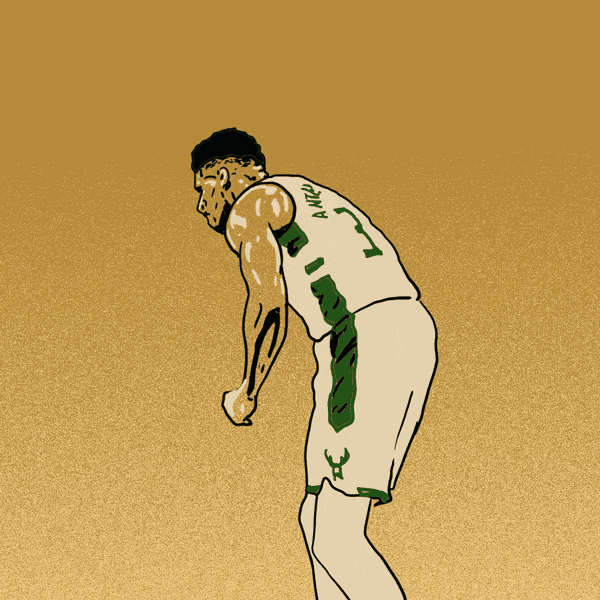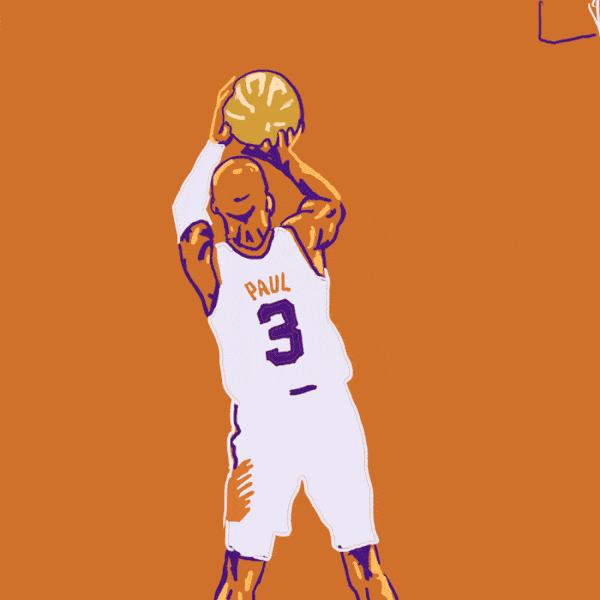
After an unprecedented NBA season, the 2021 NBA Finals are finally upon us, and they include a bunch of fresh faces. The combined rosters of the Milwaukee Bucks and Phoenix Suns include only one player who has played in the Finals before: Jae Crowder, who boasts a whopping six games of Finals experience with the Miami Heat a year ago.
There isn't a single player on either team who has won an NBA championship ring, but both squads are led by great players ready to make huge shots on the NBA's biggest stage.
Let's take a look at the go-to shots for each team that are most likely to define this series.
MORE: Series keys to Bucks-Suns in the Finals
Phoenix Suns

Chris Paul, one of the craftiest players of the 21st century, is making his Finals debut in his 16th season. It's a remarkable story brought to you by his incredible 41-point series-clinching performance in Game 6 of the Western Conference finals, which reminded us all that this old Point God can still get buckets.
Paul is one of the most gifted off-the-dribble shooters on the planet, and his ability to snake through defenses, find his own shooting space and knock down self-created jumpers is a huge part of his game and the Suns' offense.
Paul's signature shot is his off-the-dribble elbow jumper. It's both common and freakishly elite. He's been doing it for years, and he'll lean on it a lot in this series.
No point guard in the history of the game can match Paul's ability to turn pick-and-roll plays into midrange buckets. Not Steve Nash, not Stephen Curry, not Kyrie Irving. Once Paul gets going downhill off a screen, defenses might be able to take away his passing lanes or they might be able to take away his pull-up jumper, but rarely can they do both. When they yield the midrange look to him, chances are it's a bucket.
Paul shot 51.6% from midrange this season, tied for the third highest by any player over the past 25 seasons (minimum 350 FGA). The only players who outdid Paul were Dirk Nowitzki and Kevin Durant. Those guys are both a foot taller and rightfully regarded as among the best shooters ever. Paul is one of the smallest rotation players in the league, which makes his midrange numbers even more impressive.
Nobody in the NBA attempts as many elbow jumpers as he does, and it's not close. Midrange shooting has become generally frowned upon because very few players can turn 2-point jumpers into acceptable investments. A handful of superstars still can, and the Suns happen to have two of them in their starting lineup.
This season, only six players attempted at least 400 non-paint 2s; Paul and Devin Booker are among them. In a related story, Phoenix led all teams in midrange scoring this year, averaging 17.7 points per contest in the forsaken land of pull-ups and fadeaways.
Booker is the league's youngest midrange savant. While many of his contemporaries heed the Moreyball shot-selection doctrine of 3s and layups, Booker is out here playing an antiquated midrange harpsichord, defying that analytical dogma and doing so in beautiful ways.
One reason that Booker draws comparisons to Kobe Bryant is his ability to break down defenders and hit jumpers in their faces. It's gorgeous to watch, but it's also a huge part of his game. Booker is active and elite in the midrange. By making more than 49% of his midrangers this season, he ranked sixth in the NBA in midrange shooting efficiency and fifth in midrange points per game.
One reason the Suns are in the Finals is that their roster papers every square inch of court space with capable scorers.
Booker and Paul are both awesome in the midrange. Meanwhile, the Suns' role players are all capable 3-point threats. Mikal Bridges and Crowder are both prototypical 3-and-D wings, but they're not alone. Cameron Johnson, Cam Payne, Dario Saric and Torrey Craig supply Monty Williams with a fleet of dangerous 3-point shooters.
But if there's one player who has emerged to lift up the overall geometry of this offense, it's Deandre Ayton, who gives the Suns an old-school interior threat. Ayton has made 71% of his field goal attempts during the playoffs, the highest percentage in a single postseason in NBA history (min. 150 FGA).
At 22, Ayton is on pace to make a higher share of his shots than any other player in playoff history. Williams and Paul have unlocked their young center by getting him good touches and cleaner looks in his happy spot: the restricted area.
During this postseason, Ayton ranks second in the league in total points scored in the restricted area, trailing only Giannis Antetokounmpo. But get this: Ayton has made a red-hot 83% of his attempts up close, which is even better than Antetokounmpo. If Ayton gets the ball near the rim, the Bucks are in trouble, just like the Lakers, Nuggets and Clippers were.
Ayton can create his own dunks and layups. He can turn offensive boards into putbacks, and of course he's pretty good at catching lobs -- just ask the Clippers.
But Ayton is more than just a dunking machine; he's got great touch too. Out of 34 players who have tried at least 50 2-point shots outside the restricted area this postseason, Ayton's 57% conversion rate ranks third.
The Suns can do it all. They're 12-4 in these playoffs in part because the composite force of their offense is so versatile and so complementary. But can Paul, Booker and Ayton do it against the Bucks, who boast the best defensive rating in these playoffs? That's the question.
Milwaukee Bucks

As good as Ayton has been in the paint all postseason, there's one player who's been better, and that's Antetokounmpo. He is already a two-time MVP winner at age 26, and he's been the league's most ferocious interior scorer for years. He comes into these Finals as both the postseason's top rebounder and its top interior scorer. His stats near the rim evoke Shaquille O'Neal, and nobody else.
Antetokounmpo has the physical gifts of a dominant center. He stands 6-foot-11, he weighs 241 pounds and he's also one of the most explosive athletes in the game. But unlike O'Neal, Antetokounmpo does much of his damage off the bounce. He prefers to drive and Eurostep his way to his buckets, as opposed to backing his way down off post-up actions. He will post up occasionally, but his signature field goals come via driving dunks.
No player of his physical gifts has ever used the Eurostep as well as he does. His handles may not be legendary, but his strides definitely are, and his wingspan is 7-foot-4. Antetokounmpo can cover more ground with one or two strides than any other player in the world, and when you factor in that he has successfully integrated Eurosteps into his arsenal, the result is arguably the most unstoppable driving scorer in the world. One moment the ball is 15 feet away from the rim; the next it's an unassisted dunk or layup.
Since the beginning of the 2018-19 season, nobody has dribbled into as many dunks and layups as Antetokounmpo. He's racked up 804 of them and has averaged 8.7 points per game on these shots alone in that time frame.
The stats prove that Milwaukee's MVP is one of the most physically imposing players in the game. He's been compared to Shaq many times for good reason, but their paint dominance is not the only thing these two No. 34s have in common. Like O'Neal, Antetokounmpo struggles mightily at the free throw line, and there's a chance these struggles could come up big in this series, assuming Antetokounmpo is healthy enough to play (he missed the last two games of the Eastern Conference finals with a knee injury).
Heading into Game 1 of these Finals, Antetokounmpo is shooting 53.7% on free throws this postseason. The only players to record a worse free throw percentage in a single postseason (min. 100 FTA) are DeAndre Jordan, Dwight Howard, Ben Wallace, Wilt Chamberlain and of course O'Neal himself.
O'Neal overcame his free throw struggles to win three consecutive Finals MVP awards, but there's no guarantee Antetokounmpo can do the same. Much has been made of how long he takes to release his free throws, but the bigger story is simply that he misses them so much. Looking back at the Bucks' collapse in the 2019 Eastern Conference finals, Antetokounmpo's struggles at the line were costly. Milwaukee lost three games in that series by six points or fewer, and Antetokounmpo made just 11 of his 26 free throws in those three losses. If that happens again in these Finals, the Bucks might be in trouble.
If Antetokounmpo is unable to play, the Bucks will lean even more on their other All-Star, Khris Middleton, who has become one of the most complete scorers in the league. Like Booker, he's a threat from everywhere on the floor, but his signature shots are his jumpers. Those Middleton jumpers make or break Milwaukee's offensive firepower. The stats are clear:
In Milwaukee's 12 wins this postseason, Middleton is averaging 26.0 points per game, making 41.8% of his 3s and 48% of his midrange shots.
In the Bucks' five losses, he is averaging just 17.2 points per game while shooting 15.4% from 3-point range and 24% from the midrange.
With Antetokounmpo out and Trae Young hobbled in Game 6 of the East finals, Middleton had to be the best player in the game, and he was. His wide array of shooting skills was on full display in an epic third quarter. He led the Bucks on a furious run, scoring 16 consecutive Milwaukee points and finishing with 23 in the quarter, the most in a single frame in his career.
In a world where Antetokounmpo isn't 100 percent, Middleton immediately becomes the Bucks' MVP in this series. If he gets going, they can still win games without Antetokounmpo, but if he struggles, the Bucks are in trouble.
Animations by Walker TKL
